Starting Sweet Potatoes: Timing, Variety, Growing Slips, and Planting in the Garden
Have you decided you would love to add sweet potatoes to your garden, but you aren’t sure how to get started? That was me, too, a few years ago.
I stumbled my way through the varied information I could find, and somehow, I ended up with some fabulous sweet potato harvests.
While I’d never claim to be an expert on any crop in the garden, I can say this is especially true regarding sweet potatoes. In 2020, after only my second time growing sweet potatoes, and after another very successful year, I feel like I can say I learned several things on what to do and what not to do when you’re getting started growing this crop.
We talk about all of the details on this episode of the Beginner’s Garden Podcast and blog post here. Listen to the episode below or continue reading.
What climate do sweet potatoes require?
The first thing to know about growing sweet potatoes is that they definitely have a preferred climate. Knowing if you’re in that preferred climate is important so that you can determine if this is worth attempting and if so, what variety of sweet potato to plant.
Sweet potatoes thrive in long, hot summers. Southern friends. this is your crop! They do so well in that extreme heat that most other fruits and vegetables can’t handle. A long summer is necessary as it takes between 90-120 days for sweet potatoes to come to maturity. They need the heat (80s and above) for this long period of time.
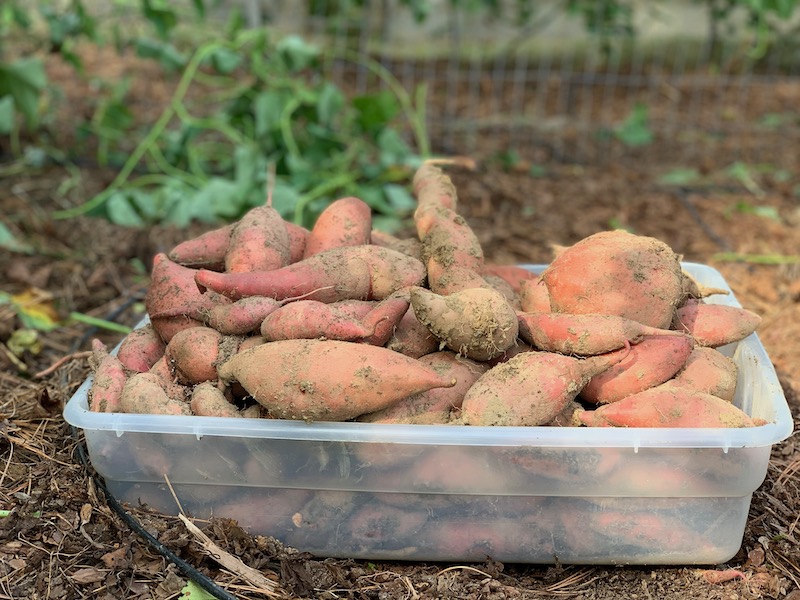
When do I plant sweet potatoes?
Sweet potato slips (which we’ll discuss below) need to be planted when the soil has reached a temperature above 70 degrees. In my area, this is 4-6 weeks after my last frost. They are more than likely going to be the last crop you plant in your garden and they need a solid 10 hours of sun.
They also need a good amount of space. Some varieties grow over 25 feet long! If you have space, consider growing these in a place where you don’t risk smothering another crop (or, companion plant them with tall-growing okra — another heat-loving crop!).

If you don’t have a large space, there are more compact, semi-bush-type varieties you can grow.
A couple of well-known bush varieties are Porto Rico, Vardaman, Jewel, O’Henry, Carolina Bunch, and Georgia Jet. Note that these will still spill out, but they won’t grow as long of vines as your traditional sweet potatoes.
What is a sweet potato slip?
I mentioned above that sweet potatoes are planted as “slips.” They aren’t seeds, and they aren’t really transplants. A slip, instead, is a small, rooted piece that develops from the previous year’s sweet potato crops.
Sweet potato slips are comprised of leaves growing up and roots growing down. When it’s time to plant, you plant them like you would any other transplant. But how do you obtain sweet potato slips?
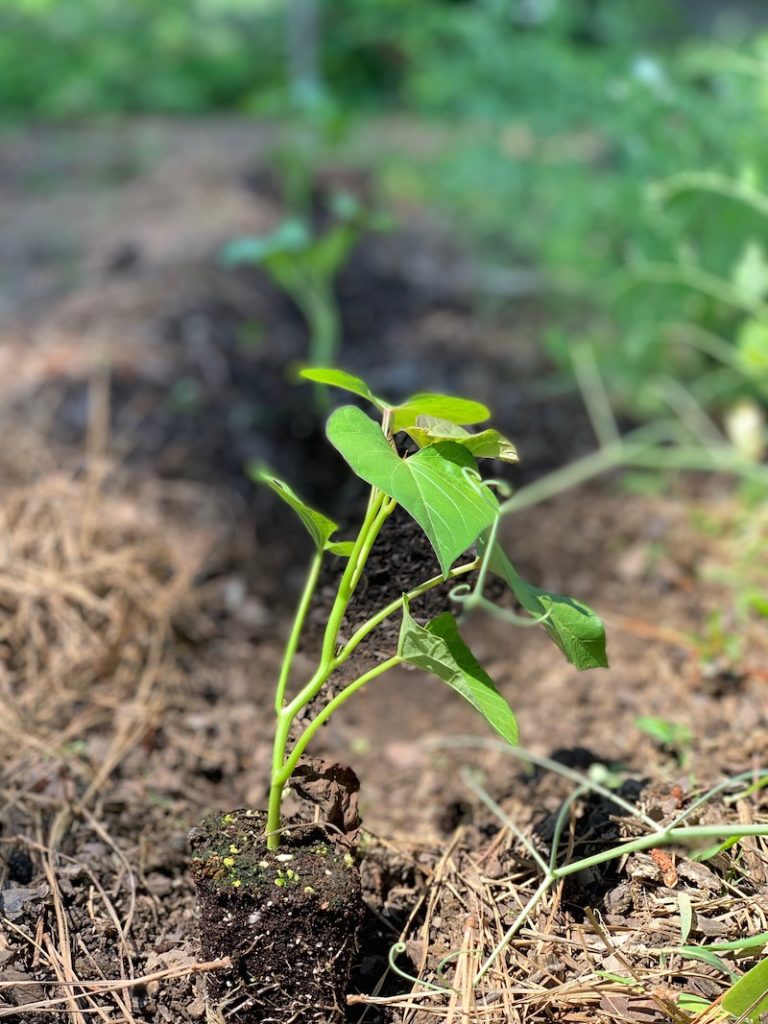
You have two options: You can grow your own slips or you can buy them. I did both my first year, and my second year I grew out slips from my previous year’s harvest. Before we talk about growing your own slips, let’s consider the easiest route: buying slips.
Buying from your local garden center is not as expensive as buying specialty sweet potatoes you may find in seed catalogs, and it’s one of the easiest ways to start.
Another benefit to buying slips locally is that your local store will have the right type(s) to grow in your region — and this is very important if you live in a shorter-season area.

How do I start my own slips?
But what if you want to grow out your own slips?
It’s so fascinating to start your own slips and watch them grow, but it wasn’t exactly the easiest process to figure out early on. There are two primary ways to grow out sweet potatoes — starting them in jars of water and starting them in soil. As I’ll share below, I highly recommend starting them in soil. However, if you want to try the mason jar method, here’s how you do it.
When I started sweet potato slips my first year, I used an organic sweet potato that I purchased from my local store because I didn’t have a previous harvest to draw from. If you choose this method, I recommend buying organic.
Take a mason jar and fill it about halfway up with water. Poke toothpicks into your sweet potatoes and keep them suspended over the mouth of your jar, with the roots submerged into the water. From there, put the jars in a south-facing window sill or under a grow light. A humid bathroom is ideal. Change your water every few days.
Start this process about 3 months before you plan to plant the potatoes in the garden.
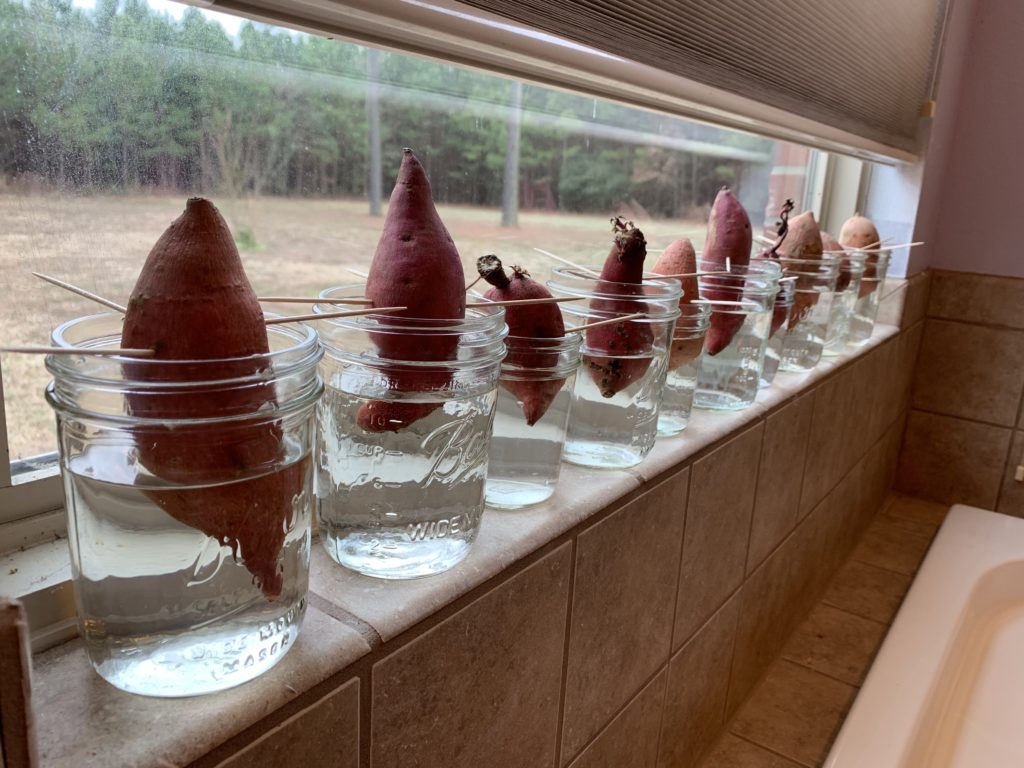
When I used this method, my sweet potatoes did, in fact, grow some slips. I didn’t get that many, though, and that’s why I had to go buy the rest of them from my local garden center.
My second year, I tried again, using my own sweet potatoes from my harvest to start my own slips. Again, the success was minimal.
After two months of waiting for my sweet potatoes to sprout, I decided to try a different method.
Starting sweet potato slips in potting soil
After having very little success with my mason jar slips that second season, I tried something new. I took a large salad container, filled it with a few inches of very moist soil, took my sweet potato and laid it on its side in the moist soil. I then added more moist soil where it wasn’t quite covered and put it under my grow lights.
I started this process two months before my planting-out date, and that timing worked out perfectly.
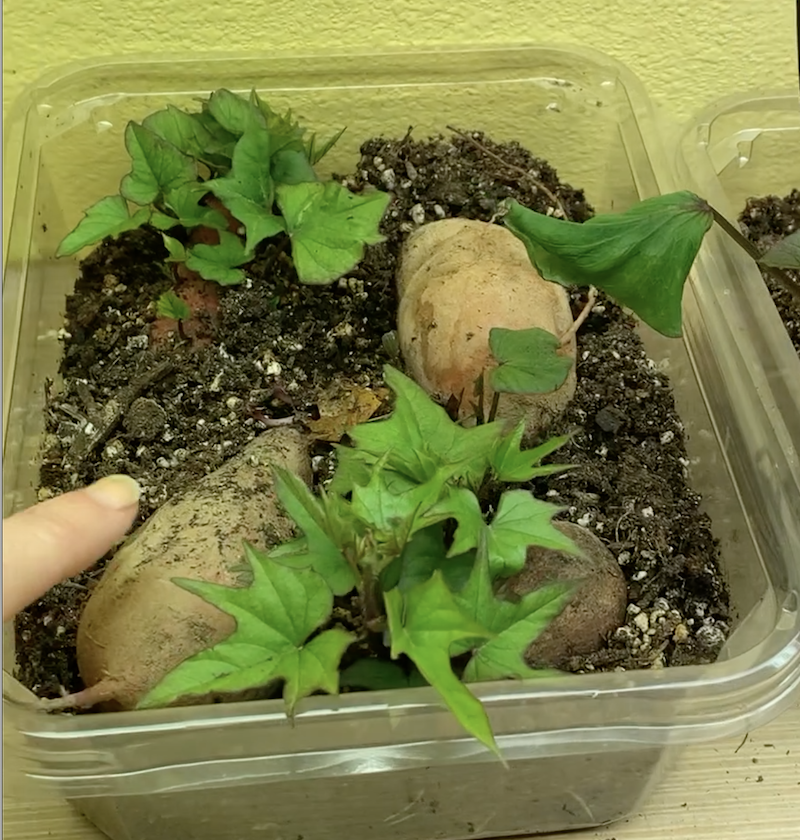
I do want to mention that you don’t have to choose the largest sweet potato; in fact, I’d recommend you choose a smaller one. A sweet potato with a 2″ diameter is perfect; save your baking-size potatoes to eat!
From here, the leaves started growing fairly quickly. I let them grow until they were about 4″ long and snapped off the slip — leaves and roots in one clump. (It’s easier than it sounds.)
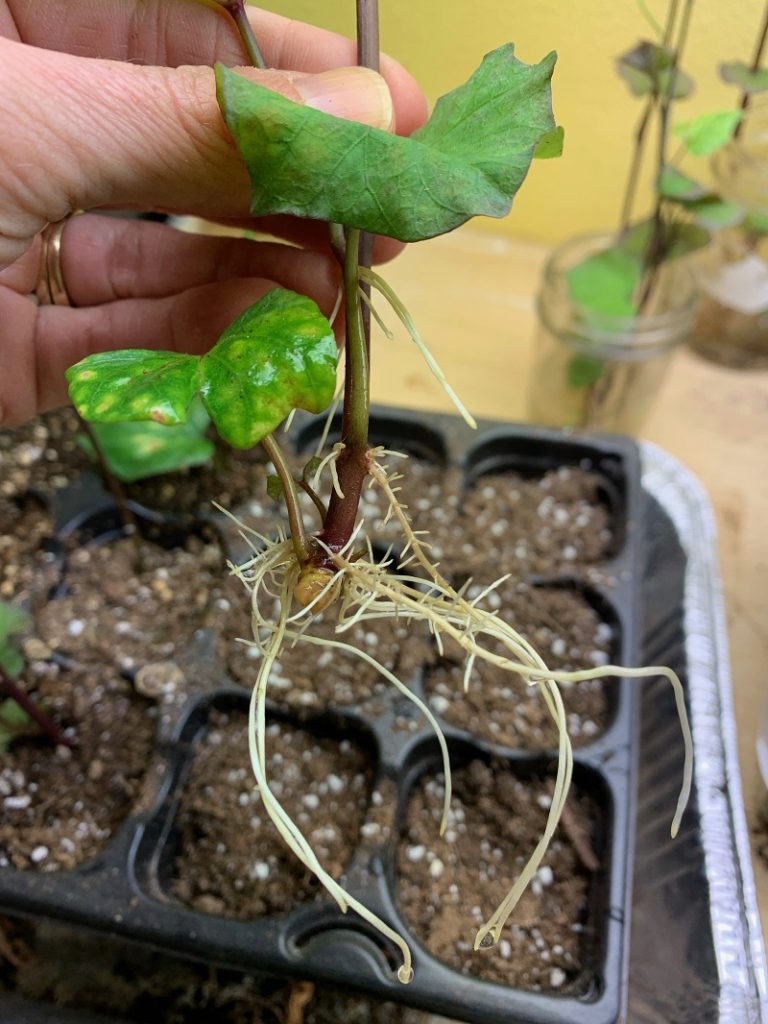
If the roots were long (like in the photo above), I planted the slips into deep seed starting trays with more potting soil. But if they were short (less than an inch), I placed them in jars of water to continue to root before placing in soil. This step didn’t prove necessary, though I liked knowing the roots were more developed when I placed them in the container.
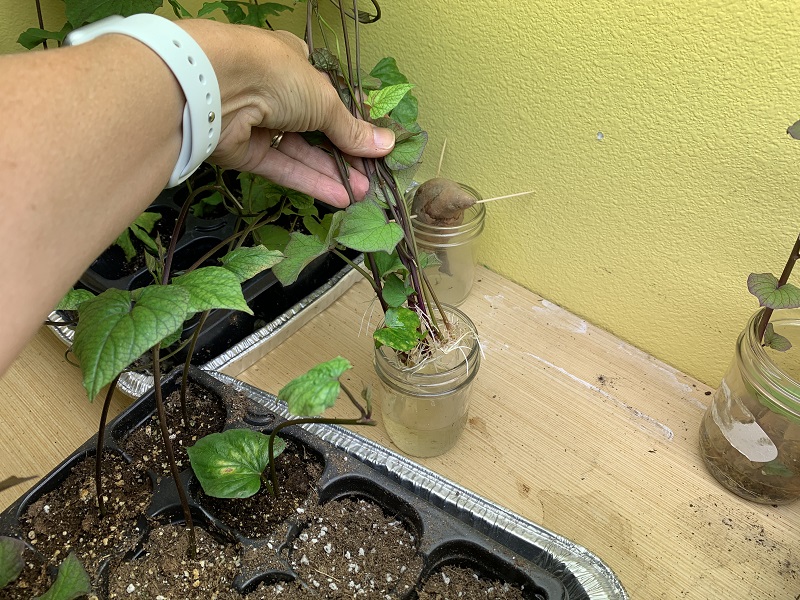
From this point, I kept the slips growing indoors under grow lights until they grew large enough and the weather was warm enough to plant directly in the garden — after a sufficient hardening off period.
What kind of spacing do sweet potatoes need?
After your soil has warmed up to over 70 degrees and your slips are ready, it’s time to plant! Plant your slips 12-18″ apart, whether you grow in the ground or raised beds. When I plant them directly in the ground, I plant double rows in a 4′ wide garden. Leaving more room is perfectly fine, though I found no competition in planting mine a bit closer together.
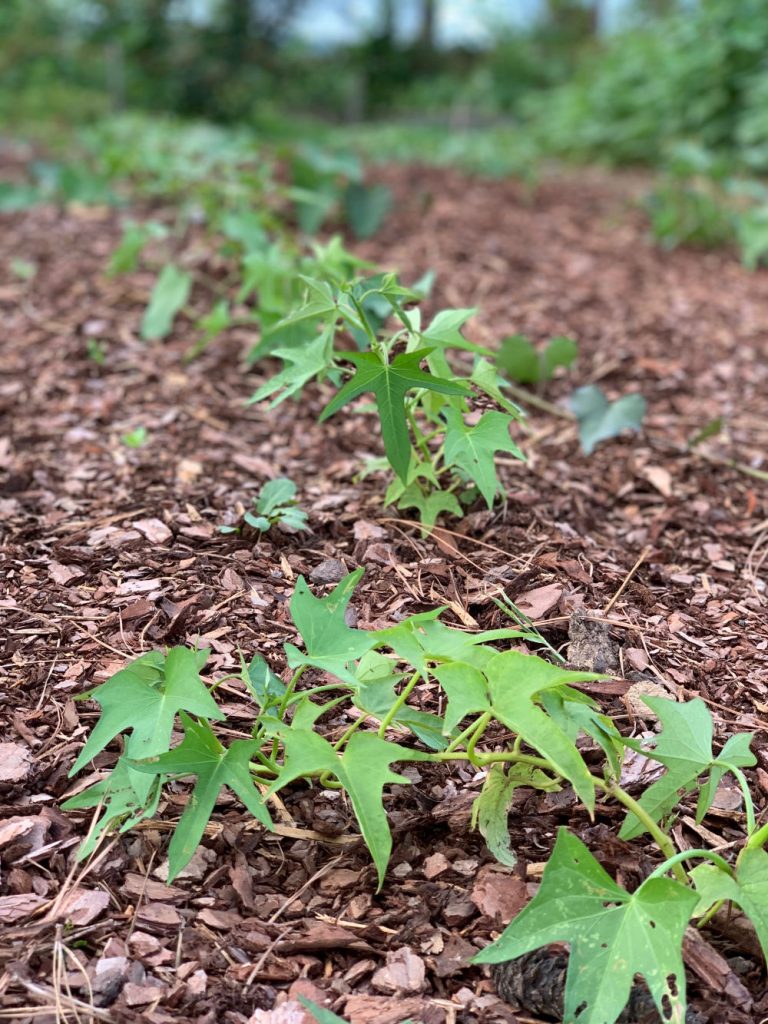
When I planted these in my raised bed, filled with high quality compost, I grew almost double the harvest than directly in the garden.
I also had a few extras that I planted in a grow bag, simply because I had no more space. They did grow, despite my very minimal efforts, but I think if I had added more compost and tended to them better, I could’ve had a larger harvest.
Do I need a specific variety?
If you live in a short-season climate, find a variety that harvests closer to the 90-day mark than the longer-season types. If you live in a long-season climate, this isn’t necessary and your options are endless!
But, I would say this. If you’re growing sweet potatoes for the first time, and really this applies to all new crops, pick a variety that’s known to be tried and true. (I grow Beauregard.) Then, as you become more experienced with them, then consider branching out to more eclectic kinds — even white or purple sweet potatoes!
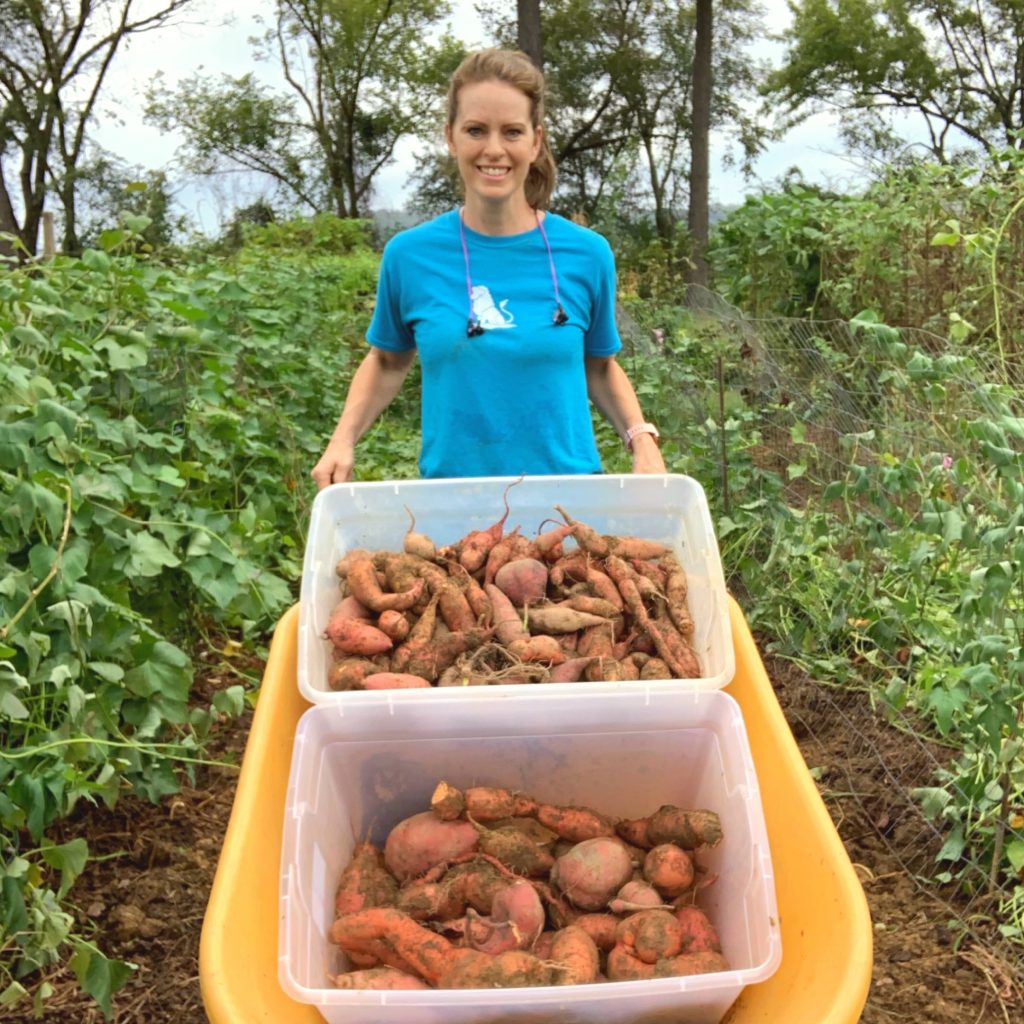
If you grow sweet potatoes this year, we want to see them! Tag us on Instagram and show us your harvest.
Do you get overwhelmed with garden planning?

Subscribe here for my best tips to plan your garden in just 7 days -- all for FREE.
Plus, I'll send you my "In the Garden E-mail" on Fridays, periodic updates on garden resources relevant to you, and you'll receive access to my entire bank of free garden downloads!
You are also agreeing to our privacy policy.

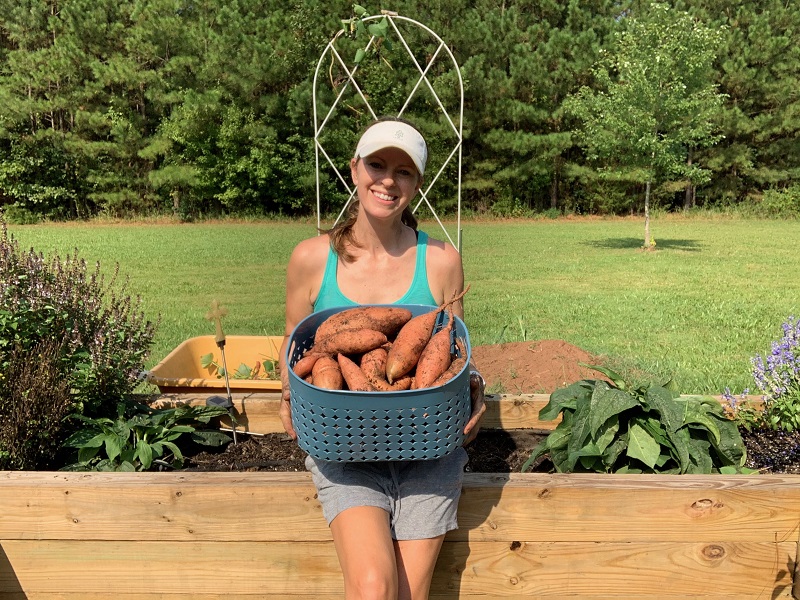
Thanks so much for the podcast on sweet potatoes. I will be trying my hands at sweet potatoes for the 2nd time this year, last year was not very successful because I planted it too late. I live in NJ where sometimes even June can be cold. I will definitely try growing slips in soil.
Yes it sure does take faith to grow anything, and I am also resting my faith on the Lord Jesus.
Thank you, Jocelyn! Best of luck with your sweet potatoes!
Where did you buy your sweet potato slips from when you bought them? Thanks!
I bought them from my local feed store.
Thanks for the guidelines. I have planted my sweet potatoes 5 days ago in my raise bed garden. I cut some slips from my ground soil plantation and now the weather is rainy and already growing healthy. This variety is orange color sweet potato. Wanted to know whats the name of this variety.
My spacing 12 inches in my 4′ x 6′ fiberglass box.
Thanks
George
I wouldn’t know how to identify the variety. I grow Beauregard, which is orange, but there are other types as well.
Hi Jill,
When I lived in Louisiana, we planted sweet potatoes slips differently. The slips were about
12″ long and had about 2 root nodules along the the slip. One root nodules were located about three inches down slip another followed at 3-4″ further. We planted these right in the garden soil, with the ends of slip out of soil. The root nodules would be planted about 1 1/2″ deep. It was fast and simple.
Lindy
Now how do I take care of the sweet potatoes? Do you make hills? How do I know when they are ready to harvest?
No, they do not require hills. I haven’t done anything special with mine so far. This video talks about when to harvest: https://youtu.be/YYbMthYBwl0
I live in California’s Central Valley where we can grow just about anything (and it gets hot!) but I haven’t noticed any slips in my local nursery. Since it’s already warm here and I’m short on space, could I try growing one by putting a sweet potato in a large pot with soil?
You could definitely try it! When I grew in grow bags, I think I just threw a few sweet potatoes in the bags, and the yield was low. I think there were several reasons, but partly I think there were too many slips that developed, so the plants competed with each other. If you choose not to grow out the slips and transplant them, just plant one sweet potato (not more than one).
Great video/post about growing sweet potatoes. About how long per day do you keep the sweet potatoes under grow lights to get slips?
16 hours per day is the time I keep my grow lights on for my seed starts, and that worked well for my sweet potatoes also.
Do you fertilize them, Jill?
When I pot them up, I add some slow-release organic fertilizer to the potting mix, but I don’t fertilize the sweet potatoes otherwise.